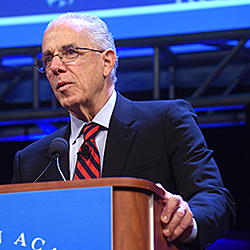Self-funded TLA Research Makes an Impact

Jeffrey A. Klein, MD – Inventor of Tumescent Lidocaine Anesthesia
Tumescent lidocaine anesthesia (TLA) was developed 30 years ago to allow successful liposuction procedures totally using local anesthesia. In decades since, Jeffrey A. Klein, MD, has expanded his knowledge of TLA so that it could potentially be used for other surgical procedures and to deliver new treatments for painful conditions.
“The more experience my colleagues and I got doing liposuction, the more we became aware that in tumescent liposuction there were virtually no surgical site infections or blood clots after surgery,” Dr. Klein said. “That is one of the big advantages of tumescent anesthesia, and it could allow us to do many surgical procedures under local anesthesia that used to be done under general anesthesia.”
Dr. Klein shared his experience with TLA Sunday when he presented the Eugene J. Van Scott Award for Innovative Therapy of the Skin and Phillip Frost Leadership Lecture, “Tumescent Drug Delivery: Lidocaine and Beyond.”
In an interview before his lecture, Dr. Klein, a dermatologist from San Juan Capistrano, California, reflected on his years of self-funded research into TLA, and looked ahead at some of its potential uses, from treating severe battlefield injuries to relieving the chronic pain of shingles.
When lidocaine was first used as a local anesthetic for liposuction in the mid-1980s, there were concerns about its potential toxicity, he said.
“But with tumescent anesthesia, the lidocaine and epinephrine are very diluted, which increases the amount of lidocaine that can be used fourfold, and it also increases the volume of local anesthetic 22-fold,” Dr. Klein said.
The medical literature in the 1980s said that peak levels of concentration of lidocaine occurred in two hours or less after injection. But as Dr. Klein tested blood levels in that time period after injection, he found the lidocaine concentration was negligible. Consequently, liposuction surgeons, including Dr. Klein, were confident there would be no toxicity as they gradually increased their dosages while carefully monitoring patients.
“Then one day, I asked a patient if I could get blood levels from him hourly for seven hours. When I got the results, the hourly blood levels were going higher and higher,” Dr. Klein said. “That told me that I didn’t know what I was doing, and neither did anybody else. I decided I had to start measuring blood levels over 36 hours. With this new data, I was able to determine that the peak lidocaine level occurs at 12 hours, not two hours.
“With that data, I could predict what the peak level would be at any given dosage. The data suggested that a conservative, but rough, estimate of the maximum safe dosage was 35 mg/kg. I published a paper in Dermatologic Surgery and Oncology that showed that 35 mg/kg was a reasonable estimate. That became an influential observation.”
Dr. Klein did research on the side as he continued his dermatology practice during the 1990s and early 2000s, and he began to think about the greater potential of TLA, especially because tumescent lidocaine seemed to reduce the risk of surgical site infections.
“I started thinking that maybe we could take this technique and apply it to general surgery or orthopedic hip replacement or even cardiac surgery,” he said. “I also wondered ‘What would happen if I were to add an antibiotic to the tumescent lidocaine solution and then inject it under the skin?’”
To test this idea, Dr. Klein carried out an independently funded pharmacokinetic clinical study reviewed by the Western Institutional Review Board.
“As it turns out, compared to intravenous drug delivery, tumescent antibiotic delivery gives sky-high subcutaneous tissue concentrations of antibiotic — much higher than what could be achieved with intravenous delivery,” he said.
As the antibiotics are slowly absorbed into the blood from under the skin, the concentration of antibiotic in the serum resembles a slow, constant IV infusion, Dr. Klein said.
“The science behind the rate of absorption of these drugs and lidocaine gives rise to the question of what other drugs could be delivered by tumescent anesthesia,” he said. “Theoretically, it could be amazing. For example, tumescent delivery of lidocaine anesthesia eliminates the pain in that area 100 percent almost immediately. If there is a traumatic wound, you can eliminate the pain and, using an antibiotic, you can prevent wound infection — all at once.
“I am hoping to get the military excited about this. If a soldier in the field is injured by an explosion or a bullet or a burn, one could use this drug delivery technique to help that soldier every step of the way.”
Dr. Klein also has experimented with using tumescent drug delivery to treat patients in pain from shingles.
“With tumescent drug delivery, you can take a tumescent lidocaine solution and put an antiviral drug in there — acyclovir — and inject that under the skin. The tumescent local anesthesia immediately relieves the patient of pain for 12-18 hours,” he said. “I have only treated a few patients this way, but they have all responded nicely.
“I am not an academic, and my research is not funded by anybody but me. This is totally investigator-initiated and investigator-financed research. I just enjoy doing my little research projects more than playing golf. I do this in my spare time at the kitchen table with my laptop open, in between conversations and interactions with my wife and kids.”
This article was reproduced from The AAD 2016 Annual Meeting News



 There is currently a shortage of sterile 0.9% Saline for IV infusion in 1 liter plastic IV bags. This shortage affects surgical procedures that use tumescent local anesthesia. The FDA is working to alleviate this shortage. Learn more here:
There is currently a shortage of sterile 0.9% Saline for IV infusion in 1 liter plastic IV bags. This shortage affects surgical procedures that use tumescent local anesthesia. The FDA is working to alleviate this shortage. Learn more here:  Download the FDA approved insert for Lidocaine Hydrochloride and Epinephrine Injection, USP For Infiltration and Nerve Block.
Download the FDA approved insert for Lidocaine Hydrochloride and Epinephrine Injection, USP For Infiltration and Nerve Block.